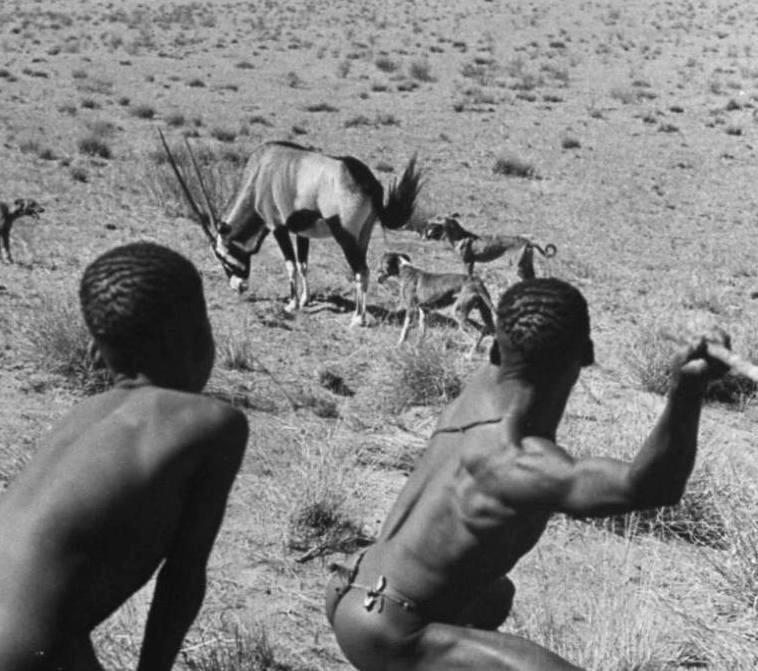
Botswana History

Figure 1.--The San sometimes called the Bush people were the first human inhabitants of Botswana. There origins are lost in time but are believed to have migrated into what is now Botswana from the north. The San who still live in Botwana provide anthropolgists a look at hunter gathers from the dawn of civilization. This photograph was taken in 1947.
|
|
The San provided anthropolgists a look at hunter gathers from the dawn of civilization. Areas of modern Botswana were developed by agriculturists without any large central organization (7-13th centuries). The Tswana dynasties rising in the east (South Africa’s Gauteng Province) conquered large areas in what is now Botwana (14th century). When the Tswana kingdoms broke up, the Hurutshe and the Kwena began to migrate east into Botwana (late-17th century). The Tswana migrants developed a well-organized state in southern Botwana (18th century). The economy was based on hunting, cattle-breeding, and copper mining. Slave rading by the Arabs to the east and the Portuguese to the west did not significantly penetrate into the Botswana area. This began to change as tribal groups to the north that were affected began migrating south to saftey (early-19th century). The Kololo were followed by the Ndebele. Developments to the south also impinged on the Tswana. The Boers began moving into the interior and forming independent states to avoid British rule. King Sechele (1829-92) allied his kingdom with the British. The British South Africa Company engineered a form of corporate colonial control. The British established the Bechuanaland Protectorate (1890). The British considered joining Bechuanaland with Rhodesia. They were unwilling to combine it with South Africa. Thus it remained a British protectorate until granted independence (1966). Inependence commenced without the Apartheid that so contorned South Africa. Botwana today is Africa's longest functioning democracy.
Pre-history
The San sometimes called the Bush people were the first human inhabitants of Botswana. There origins are lost in time but are believed to have migrated into what is now Botswana from the north. The San who still live in Botwana provide anthropolgists a look at hunter gathers from the dawn of civilization.
Ancient History
The Hottentots followed the San who were then followed by Bantu speakers who introduced agriculture. These three ethnic groups coexisted without major conflict because of their varying life style and relatively small numbers. An active trade developed among the threegrouos.
Agriculturists
Areas of modern Botswana were developed by agriculturists without any large central organization (7-13th centuries AD).
Shona speakers settled in the northeast Botswana (10th century AD).
Tswana Dynasty
The first Tswana reached south east Botswana, probably from the south. The Tswana dynasties rising in the east (South Africa’s Gauteng Province) conquered large areas in what is now Botwana (14th century).
Hurutshe and Kwena
When the Tswana kingdoms broke up, the Hurutshe and the Kwena began to migrate east into Botwana (late-17th century).
Tswana State
The Tswana migrants developed a well-organized state in southern Botwana (18th century). The economy was based on hunting, cattle-breeding, and copper mining. Slave rading by the Arabs to the east and the Portuguese to the west did not significantly penetrate into the Botswana area. This began to change as tribal groups to the north that were affected began migrating south to saftey (early-19th century). The Kololo were followed by the Ndebele. Developments to the south also impinged on the Tswana.
Boers and Zulus (1820s-40s)
Previously isolated clans began to form into tribal bands along what is now the Botswana and South Africa border (1820s). This was the result of developments to the south. The British seized Dutch Cape Colony during the Napoleonic Wars. The Boers were moving into the interior and forming independent republics in an effort to escape from British control. Another major development was the development of a militantly militaristic Zulu state which steadily expanded. The result was a flood of people out of Transvaal and Natal into what is now Botswana. The clans already in Botswana organized defensives against the flood of refugees from the south.
Bechuanaland (1885)
King Sechele (1829-92) in Botswana pursued an alliance with the British. This was the befinning of British colonial cintrol. The British South Africa Company pursued activities in Botswana that evolved in a colonia system. The borders were defined with the declaration of the Bechuanaland Protectorate (1885). The primary British concern leading to the Protectorate was the ecalating rivalry between the British and the Boers. It bordered German West Africa (Namibia) and the Boer republics to the south. The British built a railway through Bechuanaland to Rhodesia (1890s). This and a particularly serious outbreak of rinderpest destroyed what had been a flourishing transit trade. The British considered joining Bechuanaland with Rhodesia. They were unwilling to combine it with South Africa. Thus it remained a separate British protectorate.
Independence (1966)
Britain granted independence (1966). Inependence commenced without the Apartheid that so contorned South Africa.
The country's first president was Seretse Khama. He had been exiled by the British, but returned as a chief. Botswana at independence was heavily dependent on South Africa for food imports. It also relied on the earnings of Botswana mine workers in South Africa for foreign exchange earnings. President Khama vocally opposed arparthied innSouth Africa. He also committed his country to the so called front line states in opposing the Smith regime which attempted to impose a white-dominated regime in Rhodesia. Smith responded with attacks on Botswana. Botwana today prides itself on being Africa's longest functioning democracy.
HBC

Navigate the Boys' Historical Clothing Web Site:
[Introduction]
[Activities]
[Biographies]
[Chronology]
[Cloth and textiles]
[Clothing styles]
[Countries]
[Topics]
[Bibliographies]
[Contributions]
[FAQs]
[Glossaries]
[Images]
[Links]
[Registration]
[Tools]
[Boys' Clothing Home]
Navigate the Boys' Historical Clothing national pages:
[Return to the Main African country history page]
[Return to the Main African page]
[Angola]
[Cameroon]
[Cape Verde Islands]
[Democratic Republic of the Congo]
[Ethiopia]
[Gabon]
[Lessotho]
[Liberia]
[Madagascar]
[Mali]
[Nigeria]
[Somalia]
[South Africa]
[Uganda]
Created: 8:12 AM 9/3/2010
Last updated: 8:12 AM 9/3/2010



